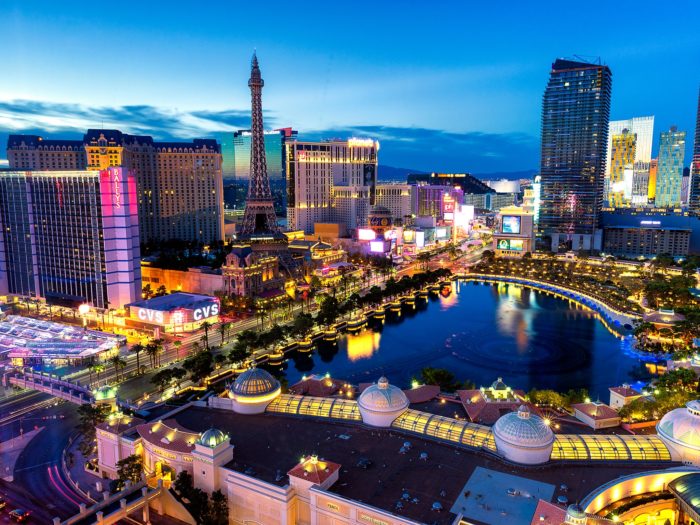The Brave New World of Las Vegas Architecture
Las Vegas! I spent four days there last week, alternating my time between attending the Inman Connect Conference, where my daughter Clelia was conducting interviews and moderating panels, and being the manny for her 6-month-old daughter Frederica. The experience gave me a lot of time to think about Vegas, especially as an architectural drawing board. Word class architecture exists cheek-by-jowl with absolute shlock, with no regard to consistency or a sense of the aesthetic whole. There’s nowhere else like it in that regard, except perhaps Beverly Hills. So how does architecture itself contribute to the overall mission of the strip, which is, of course, to compel people to gamble and shop as much as possible?
A bit of history: Las Vegas, named for the billowing grasses which once filled the valley owing to underground springs, was incorporated as a town during the first decade of the 20th century. Although gambling, prostitution, and betting were all against the law, enforcement was lax and several towns in Nevada, including Ely, became notorious. With the legalization of gambling in the early 30s, and changes in divorce law which made Nevada the state with the shortest residency requirement in the country (six weeks), Vegas began the trajectory which made it what it is today. With the construction of Bugsy Siegel and Meyer Lansky’s Art Deco-inspired Flamingo Hotel in the late 1940s, the era of super-deluxe hotels arrived, and remains to this day.
Unlike New York, the architecture of which I have studied throughout my four decades in the real estate business, the growth of Las Vegas is completely inorganic. In New York demand fuels new building creation as the city grows. In Las Vegas the buildings are built, each fancier than the last, to CREATE demand. And to judge from the City Center complex, the planners are getting better at it.
The overwhelming retro nature of some hotels: faux Rome at Caesar’s Palace, faux Paris at Caesar’s Paris Las Vegas, faux Manhattan at New York-New York, faux Venice (including gondola rides through shopping arcades tricked out to look like the Piazza San Marco) stands in stark contrast to the City Center, which contains hotel and shopping complexes by some of the world’s great architects.
We stayed at the Aria, designed by Pelli Clarke Pelli. The architecture is striking both outside and in. On the exterior, two counterpoised ellipses rise over many of the surrounding buildings. Inside, the soaring, light infused public spaces, filled with world class art (Maya Lin’s “Silver River” over the main reception desk is a standout) create a sense of expansiveness, which then emphasizes the transition into the darker, lower ceilinged, enfolding space which houses the windowless casino. Once within, the 150,000 square foot casino space wraps itself around you, dim and seductive, with a maze-like design which makes it hard to exit. It’s a prime example of form enhancing function. The Rafael Vinoly-designed Vdara Hotel mirrors his less is more aesthetic, and Daniel Liebeskind’s Crystals shopping area contains the world’s most expensive stores within a sharply angled exterior which penetrates the Vegas streetscape like a group of exclamation points. Within, the individual brands are all angled one against another so as to make each store seem, for a moment, like the only one you see.
Las Vegas offers the visitor the opportunity to recapitulate much of the architectural history of the past 50 years. The city itself is a construct, booming only because of the advent of air conditioning and the diversion of VAST amounts of water from the Colorado River. Unlike the locations of New York, or St. Louis, or Chicago, nothing about the placement of Vegas intrinsically makes sense. It’s the middle of the desert. And this anomalous and overriding sense of dislocation and fantasy plays out in the city’s architectural eclecticism.
The early hotels attempted to borrow “glamour” by copying some of the world’s most famous buildings and monuments in miniature, with the Grand Canal, the Eiffel Tower, and the Trevi Fountain within a stone’s throw of one another. But as time went by, and more convention attendees and high rollers arrived, the starchitects, like the restaurateurs, began to arrive. Is there anywhere else in the world where a couple of square miles contain work by Frank Gehry, Cesar Pelli, Daniel Liebeskind, Rafael Vinoly, Helmut Jahn, and more, all mixed up together with no apparent sense of place or raison d’etre outside of luring customers? Seeing these new buildings, and the way they manipulate the public spaces and the gambling spaces, or entice the shopper, creates a 21st century perspective on the use of design to define and create not only spaces, but also experiences. Las Vegas is the avatar of a brave new architectural world.


